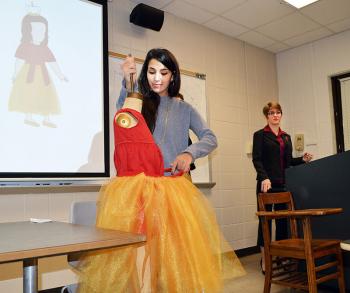
Victoria Cleveland talks about a line of Bohemian children’s wear she and several of her LSU College of Agriculture’s Department of Textiles, Apparel Design and Merchandising classmates designed as part of a project in their textiles and apparel product development class. The class is designed to teach students the steps for starting their own apparel design business.
--Tobie Blanchard Photos

Kristi Condon, a student in the LSU College of Agriculture’s Department of Textiles, Apparel Design and Merchandising, demonstrates how her team’s line of children’s wear can transform from a normal child’s dress to a princess costume, while Rebecca Stephens presents the team’s business plan.
LSU apparel design students try fashion’s business side
BATON ROUGE — Rebecca Stephens has always loved dressing in costumes. The LSU College of Agriculture junior felt stifled as a child by regular children’s clothes.
Now she is pursuing her passion for costumes by majoring in apparel design in the college’s Department of Textiles, Apparel Design and Merchandising. In the textile and apparel product development class, she and her classmates worked in teams to develop lines of children’s wear.
Stephens used this opportunity to create girls’ clothes that can easily transform from dinnertime to playtime.
“As someone who specializes in costumes, my heart goes out to children who want to play dress-up but can’t because they need to go to the grocery store or out to dinner,” Stephens said.
The line she and her team created for their fictitious business they named, Just Like That, includes dresses appropriate for outings with easy accessories that can turn a plain shift dress into a princess or fairy costume.
Stephens and her team presented their business plan to classmates and an audience acting as potential investors in their start-up apparel company.
Laurel Romeo, assistant professor and teacher of the class, helps students understand what it really means to start your own line of clothing, which many apparel design and merchandising students aspire to do.
“They go through the steps involved. They have to work in teams I assign,” Romeo said. “They need to realize there is business behind it. It is not just designing.”
The students had to create a budget that included things like rent, insurance and lawyer fees. Romeo said they had to conduct research to find out how much items costs and contact a real estate agent to see what rent might be for their offices. They had to determine manufacturing costs and show their profitability.
“It is a lot to consider,” Romeo said.
The students also had to investigate their target market.
“You can’t just design what you want. You have to design for the market and within the constraints of federally-mandated laws governing children’s apparel,” Romeo said.
The prototype and designs the Just Like That team showed the audience included dresses and accessories in warm tones such as rich red, emerald green and gold.
“We eliminated white and blue to avoid the Elsa craze,” Stephens said, referring to the popularity of those colors in children’s clothes because of the Disney movie “Frozen.” She said her team was predicting a shift away from those colors.
Other teams presented lines that included Bohemian wear for “oddball” girls who deserve a place in the apparel industry, gender-neutral clothes made to be handed down, and rain wear. The team behind Rainy Anna designed a raincoat and overalls with a QR code that could be scanned to check the weather.
“Some of their ideas are very innovative,” Romeo said. “I think they did well, and I know they put a lot of time into it.”
Romeo said each team was required to keep a time log of all activities involved in formulating their company, researching the target market, designing their line, and creating the prototype garment. Teams spent as many as 215 hours on the project.
Stephens said it was a tough assignment, but one she is glad to have accomplished.
“It was a shell shock at first, but it forced us to consider the aspects of owning our own business,” Stephens said. “We learned to think for ourselves and adapt to the current market. Now we have the experience of putting a plan together.”
- Log in to post comments
